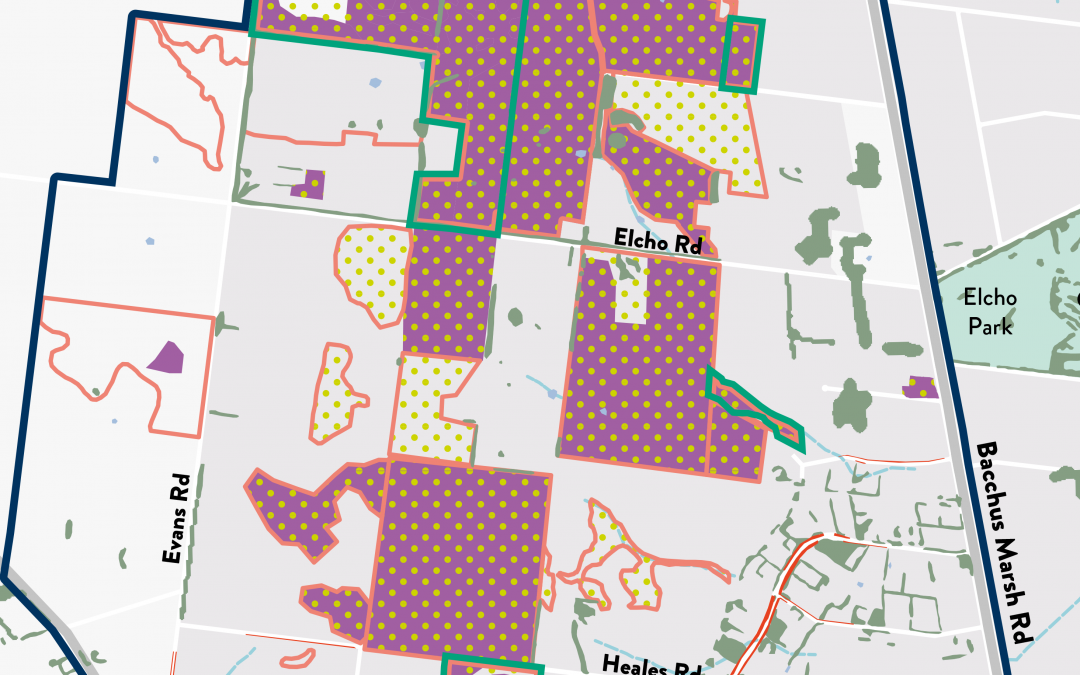The stakes are high. The Geelong Strategic Assessment is going to fast-track the development of 6000 hectares that includes endangered grassland, grassy woodland and the Moorabool River. Developers stand to make windfall profits at the cost of the environment.
The Northern and Western Geelong Growth Areas are on track to become Geelong’s newest suburbs. It’s country that contains many ephemeral watercourses and critically endangered seasonal herbaceous wetlands. These are places home to federally-listed Striped Legless Lizards, Golden Sun Moth, Spiny Rice-flower and state-listed species such as Leafless Bluebush and Melbourne Yellow Gum.
Much can be gained by integrating considerations of natural values into the planning processes at the earliest stage possible. If done well, this can allow the establishment of interconnected areas of biodiversity, reduction in fragmentation, better protections, reductions in weed impacts, reduction of risk, early identification of strategically important assets, and greater certainty for developers, planners and the community.
But the disastrous Melbourne Strategic Assessment showed that fast-tracked development can mean poor processes, big savings for developers, all the risk borne by the environment, and the loss of irreplaceable natural areas. So many promises and commitments, so much failure to deliver.
The Grassy Plains Network is working hard with local environmental groups to make sure the City of Greater Geelong does the right thing. We are just at the start of a long process, setting out the brief for what the Geelong Strategic Assessment will be, but already there’s plenty of secrecy and a whiff of cronyism – for instance, the City of Geelong is withholding a vital flora and fauna survey.
In order to achieve genuinely good results for the environment and for people, it is critical we get the planning right now for this substantial planning activity. But the draft Geelong Strategic Assessment is not shaping up well. You can read our full submission here. In summary, its flaws include:
INSUFFICIENT DETAIL: The Geelong Strategic Assessment provides insufficient detail on processes for approvals, timelines, sequencing, consultation, hold points, mechanisms for enforcement, and responsibilities.
FAST-TRACK DEVELOPMENT: The Geelong Strategic Assessment is a pro-development fast-tracking process. It has not appropriately considered the cost to the environment. The Fauna and Flora Guarantee Act places a duty of care on the City of Greater Geelong to pay proper consideration to the environmental values present in the Northern and Western Geelong Growth Areas.
SECRECY: The City of Greater Geelong is engaging in a culture of secrecy by failing to release its reasoning for the need for a strategic assessment, and by not releasing the fauna and flora assessment it has undertaken across the Northern and Western Geelong Growth Areas.
REPEATING MISTAKES: The Geelong Strategic Assessment is repeating a major mistake made in the Melbourne Strategic Assessment, in that it is approving an outcome without providing detail of how that outcome will be achieved.
THREATENED SPECIES IGNORED: The Geelong Strategic Assessment provides no information on how matters of state and federal significance will be aligned. Over 60 grassland species are listed as threatened in Victoria. How are these to be protected?
OFFSETS UNCLEAR: The Geelong Strategic Assessment provides no information on how offsetting is to proceed.
CONSERVATION AREAS UNPROTECTED: The Geelong Strategic Assessment provides no processes by which conservation areas are to be appropriately protected and managed.
NO CHECKS AND BALANCES: The Geelong Strategic Assessment provides no information on what checks and balances will be in place to ensure good outcomes for the environment and the people of Geelong.
RUSHED AND POOR SEQUENCING: On-ground assessments have begun on the Creamery Road and Elcho Road East PSPs. How can commencing these PSPs align with the strategic goal of providing interconnected biodiversity reserves across the whole of Northern and Western Geelong Growth Areas? The intention of the Biodiversity Conservation Strategy is to establish a whole-of-growth-areas strategy prior to the PSP process.
WEAK: The Brief is weakly worded.
